When it comes to traction, it goes without saying that four wheels are better than two. Twice the rubber pulling on the road means more get up and go when you need it. Thanks to technology we have a vast array of different ways to make that equation work for us. With so many options it’s easy to get lost. Let’s take a look at the differences and see if we can better understand the Nissan four wheel drive and all wheel drive systems, how to tell them apart and, most importantly, where to look when something goes wrong.
As technology advances we have more opportunity to give the consumer so much more of what they want in a vehicle, and even provide some features they never knew they couldn’t live without. Even if it is never used, the security of knowing a truck has four wheel drive is an excellent selling point — for safety, for the beefy appearance, or just for the potential of playing in the mud.
We have all seen the commercials where an all-terrain tire is slinging mud in slow motion as the truck bounces down a forest road or construction site. The driver is just grinning as he knows his truck is the toughest on the trail.
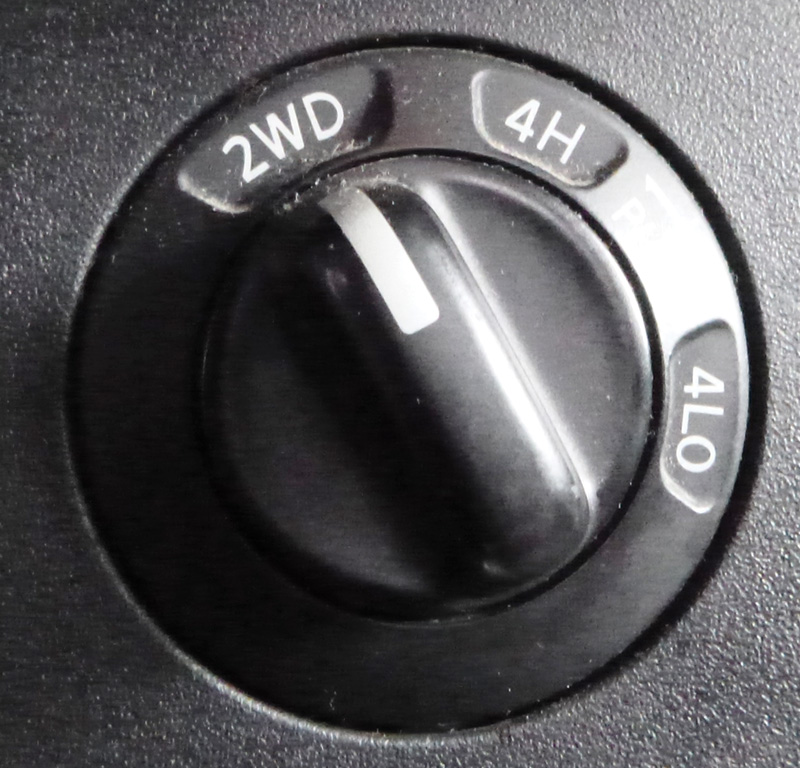
In replacing the old-fashioned transfer case shift lever, this on-dash switch makes changing to four wheel drive, and back again, very easy. The switch is accompanied by an electronic shift actuator on the transfer case.
On the other side of the coin, we can’t discount how all wheel drive gives the sense that the vehicle is secure and glued to the road, giving confidence to a driver in the storm with rocks falling on the road in their path as the small child sleeps in the back seat. There is no “fun†here, just a sophisticated car owner that made the right choice in the safety feature known as all wheel drive.
Both systems seem to have the same meaning, that all four tires put power to the ground. In fact many of the same components make each system work. So why have different names?
It really isn’t a big, complex secret, and there isn’t any hard and fast rule in the actual wording. Generally speaking, four wheel drive is an aggressive locking of the drivetrain for maximum traction that can be applied by the driver at will through a gear shift, or electronically with a switch. This is the system you will have on trucks and SUVs that are intended to go off road.
All wheel drive, on the other hand, is a passive system that is either active all the time or is activated and deactivated by a sophisticated computer control system. It is flexible enough to provide the appropriate traction for any driving conditions and still keep fuel mileage as high as possible. This is the safety feature that will keep the car moving as the snow falls and makes it possible to get those cookies safely to grandma’s house.
The big hurdle that has to be overcome in any system having all four tires tied to the drive train is that at some point the driver might want to turn the vehicle. When a car is going in a straight line, barring any difference in tire size, all four axles turn at the same speed. As soon as you turn the steering wheel, all four axles turn at different speeds.

It says AWD on the badging of this 2013 Juke, but what does that really mean, and how does this system differ from a regular 4×4?
In a turn the outside tires travel a longer distance and must rotate faster, while the inside tires rotate slower, the front tires slightly more so than the rear. 4×4 systems drive like a standard two wheel drive, usually rear wheel drive, until the driver decides extra traction is needed, such as in icy conditions. The driver then locks the vehicle into four wheel drive without worry of the tires binding due to the difference in speed while turning, since they can slip as needed to make up the difference.
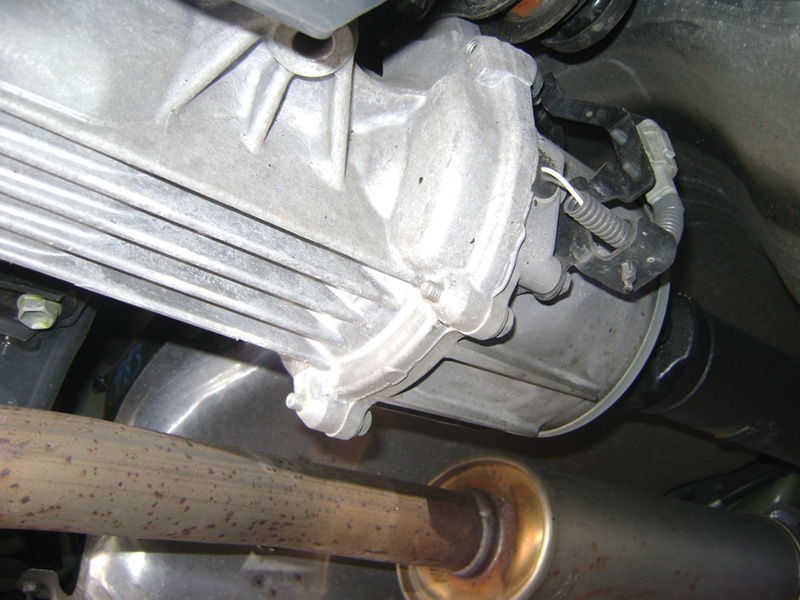
This housing holds an electronically controlled clutch pack that is disengaged when the computer determines that the rear wheels don’t need torque, improving fuel mileage.
When traction is restored by driving onto a solid, clean road surface, the driver is quickly reminded to shift back into two wheel drive by the binding in the system as all four tires gain traction once again. This binding action is often referred to wind-up. These are the systems you will find in the trucks and taller SUVs like the Frontier, Titan, Xterra, and older Pathfinders.
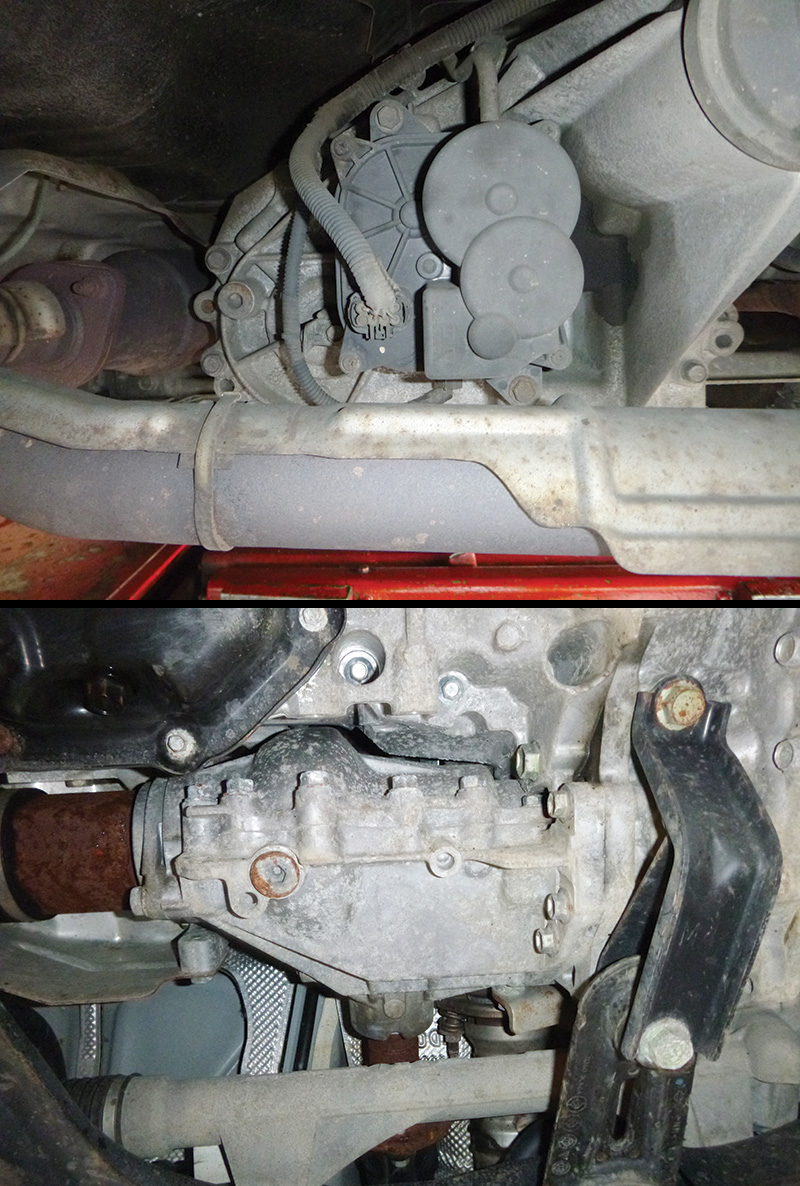
Both of these are transfer cases. The AWD model is simply dividing power between the front and rear, whereas the 4×4 model has shifting capacity for front axle engagement, neutral, and even a lower gear set for particularly rough terrain.
All wheel drive is either designed to be engaged all the time or is controlled by an on board computer and has no driver controls to turn the system on and off. The system has to automatically compensate for the difference in tire speed and, until recently, that made it necessary for the system to be less aggressive than the 4×4 version.
Different methods are used to introduce “slip†into the system, such as a viscous coupling, an extra differential in the transfer case and, more recently, electronically controlled clutch packs that can engage and disengage axles or even individual wheels as needed. The latest versions use computer controls that determine if a wheel is slipping and transfer power to the wheels that aren’t. This gives the driver all the control they need and they never even realize it’s happening. These are the systems you will find in shorter SUVs like the Juke, Murano, newer Pathfinder and Rogue as well as performance cars like the Infiniti G35x and GT-R.
Although mix-ups should be rare, being precise about which system you’re working on is a good idea. The main reason is in customer confidence. The four wheel drive and all wheel drive systems are different enough that actual diagnostics for any problem would be difficult to confuse. Ensure that your customer is confident that you know difference by using the correct terminology, especially if they ask you, out of curiosity, what the difference is. By necessity both systems will have certain components in common, although they will look wildly different. After the transmission there will be a transfer case, drive shaft, differentials and axle shafts for each wheel in both systems.
Take for example the transfer case on an AWD Murano and the transfer case on a 4×4 Frontier. The AWD transfer case, with a setup similar to that used in a front wheel drive vehicle, is in line with the right front axle shaft and has a small ring and pinion gear that converts the torque perpendicular to reach the rear axle with a long drive shaft. It’s very small and only holds about half a pint of gear oil.
The 4×4 vehicle, with a setup similar to that of a rear wheel drive vehicle, has a transfer case bolted to the tailshaft of the transmission. It then has output yokes forward and rearward for short drive shafts to the front and rear axles respectively, as well as a built-in mechanism to engage the front axle drive shaft or reduce the transmission gear ratio for 4LO operation. This unit is much larger and holds over 2 quarts of transmission fluid. Both have the same basic function of torque distribution but will have different maintenance and diagnostic needs due to how they are used.
Extra maintenance for AWD and 4×4, as compared to two wheel drive, is required in that they have transfer cases and differentials that require fluid changes at regular intervals. The intervals are usually quite long and thus frequently neglected. It’s a good idea, when doing these services, to use genuine Nissan fluids as many of these transfer cases have seals and clutches in them that require specific fluid properties. Problems caused by using incorrect fluids may take a lot longer to manifest than similar mistakes in an engine or transmission, but can still be quite costly to repair when they do. Ensuring you have the right fluid can save you in the long run.
Diagnostics for four wheel drive systems are typically pretty straightforward; verify proper function without strange noises. Before searching for any fault, tactfully make sure the customer isn’t simply misunderstanding how and when to use four wheel drive.
Accidentally having the front axle engaged will feel like a serious problem when maneuvering in a parking lot. Likewise, having bumped the transfer case gear shift into neutral might have a driver thinking their truck has a serious transmission fault. Listen carefully to the customer’s description of the problem then verify the concern.
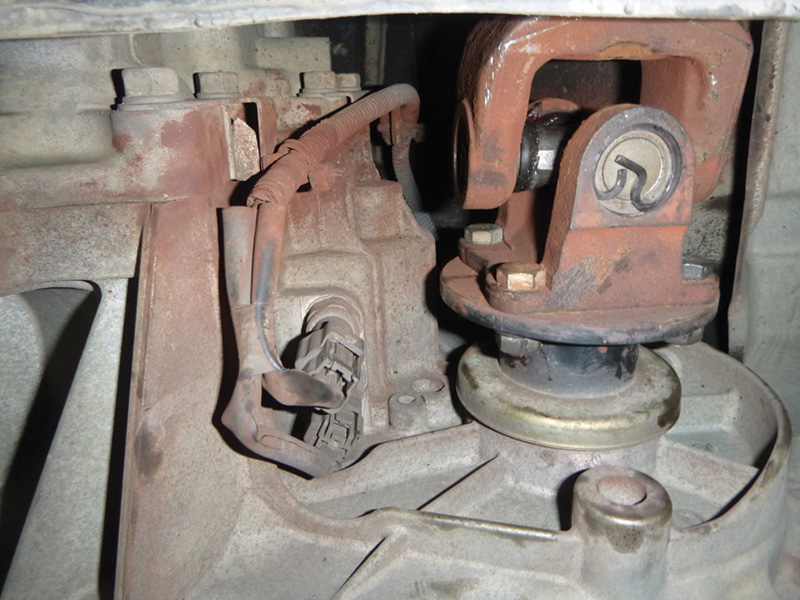
Simply looking at the transfer case we see the tell-tale blanket of rust indicating a failed Cardan joint. Catching these failures early can prevent further damage to the driveshaft yokes.
Even though it seems relatively simple, the four wheel drive transfer case is not a system you want to guess as to what’s wrong by the description of the problem. Clunking noises are very common as Cardan joints (C-V joints) frequently wear out, but it could be a worn gear in a differential or even a broken spring mounting allowing a rear axle housing to shift under tension. Â
A quick test to verify the 4×4 function is to place the truck in drive in 2HI, turn the steering wheel hard to one side and coast about 10 feet. Then repeat these steps in 4HI. The truck should coast smoothly in 2HI and come to a halt after a couple feet in 4HI as the drivetrain “winds up,†meaning the gears bind up because the tires are turning at different rates. If the vehicle coasts the same both times you know there is a problem to further diagnose as the front axles are not engaging.

This amber AWD light is the AWD drive version of a check engine light. It should come on when the key is turned on then turn off after a short time. If it remains on or flashes there is a problem that needs to be diagnosed.
The next step is identifying if the problem lies in the front differential or in the transfer case. With the truck in Park (or first gear with a manual transmission) and in 4HI, lift the wheels off the ground and try to turn the front driveshaft. If the shaft doesn’t turn you should be looking at the front axle and hubs for a problem. If it does turn, you’ll be looking at the transfer case and possible control side problems. This is basically a divide and conquer method. Since the system is basically two separate components linked with drive shafts it’s easy to isolate the fault to a particular component.
All wheel drive systems can’t be verified as simply as the 4×4 systems can. Typically, faults will be noticed as noise or fault indicators on the instrument panel like an amber AWD light and stored codes in the computer. Since the computer monitors wheel speed, transmission and engine sensors will likely turn on more than one fault indicator. Issues that will turn on the light might range from simply having low tire pressure at one wheel to having a failed magnetic clutch pack.
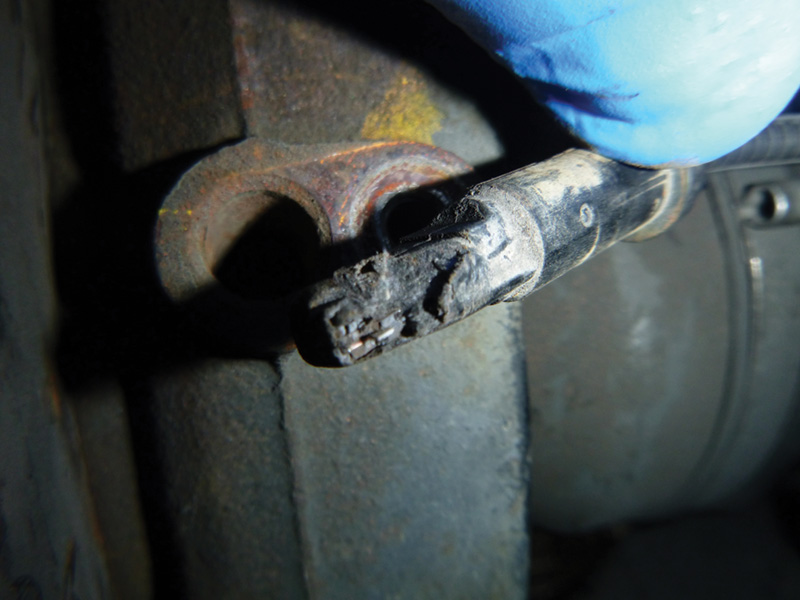
The customer didn’t notice that the green AWD light was now amber in this Murano. A failed wheel bearing physically damaged the wheel speed sensor, causing a fault in the AWD system.
A fault code isn’t always the only thing that can indicate a problem in an AWD system. Many systems use electrically actuated clutch packs at the axle or differential as a means of applying torque to the specific axle. These clutches can wear out or become contaminated with fluid from a leaking rear differential pinion seal. Sometimes they will make strange clunking noises as they engage, or even moaning, grinding noises as torque is applied by turning in tight corners.

On some modern AWD vehicles, like this 2013 Juke, each axle has its own clutch pack to apply torque where it’s needed and remove it from where it isn’t. New technology also means more parts that can fail in new ways.
It should be noted that not all AWD systems are designed solely as a safety feature for grocery-getting crossovers. The strongest system is the Advanced Total Traction Engineering System for All-terrain with Electronic Torque Split, or ATTESA E-TS. This is used in the sports cars like the Infiniti G35x and the Nissan GT-R. The system has been credited with keeping the GT-R ahead of many seemingly better equipped supercars. ATTESA E-TS basically applies the torque of the seriously over-powered engine firmly to the ground in an almost magical way. By sensing for slip it can vary the torque applied from front to back and even side to side, keeping the power on the ground.
When servicing vehicles with AWD there are certain precautions you have to keep in mind. Obviously jacking up the front end and putting it in gear to listen for a bad wheel bearing will end poorly with an AWD vehicle. There are other things to consider as well. Tire pressures must be kept at the manufacturer’s recommended pressure. This is usually found on a sticker on the driver’s door jamb. Having incorrect tire pressure changes the effective diameter of the tire and can affect the AWD performance. In extreme cases it may even set a code.
Care must also be taken in selecting replacement tires. The tires must be the same size both side to side and front to rear. Even having badly worn tires on the front and new tires on the rear can cause issues, as the thickness of the tread affects the diameter of the tire and the axle rotation speed. It may sound like a sales pitch to sell more tires but it is valid in that all four tires need to be as close as practical to the same rolling diameter. If a flat is replaced with a poorly sized spare, it may trigger a fault code and deactivate the AWD.
As technology continues to evolve we are seeing the differences between these two types of drive trains diminish. Many AWD vehicles now have a button to push that will activate all four wheels at lower speeds, much like a 4×4. This allows the driver to be proactive if they know a slick spot is coming. In a system that’s otherwise automatic, would this not make it a 4×4 vehicle? In this case, since the system will activate automatically and the vehicle is still safe to operate on standard roads, AWD is still appropriate. As long as adventurers will leave the road in search of mud, sand, and really steep boat ramps, locking transfer cases and low range four wheel drive will continue to be popular.


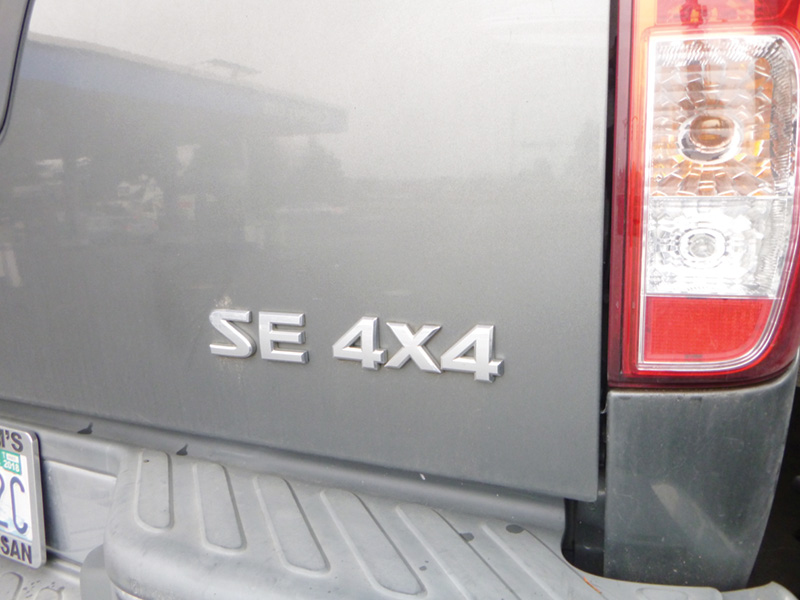




0 Comments